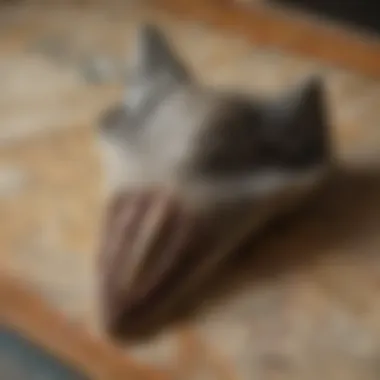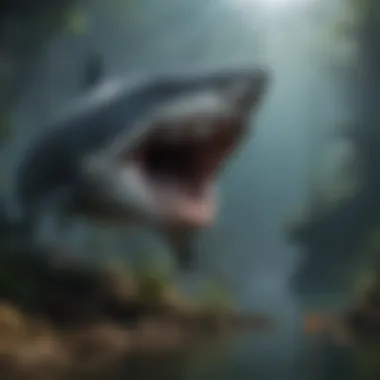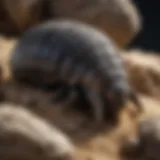Megalodon Tooth Sizes: A Comprehensive Analysis


Intro
The megalodon, known technically as Carcharocles megalodon, is often considered the titian of prehistoric marine predators, leaving behind impressive teeth that provide vital clues to its existence and lifestyle. These teeth, large and fearsome, have captured the imagination of both scientists and collectors. This article seeks to provide an insightful examination of these remarkable remnants, starting from the very basics of identifying megalodon teeth, then moving into collecting tips and preserving these unique fossils, while also incorporating discussions on the geological significance of the habitats they come from.
Rock and Fossil Identification
Identifying megalodon teeth correctly involves more than just recognizing their sheer size. Knowing the characteristics that distinguish their unique shapes and sizes is essential for collectors, whether they're just starting or have been around the block a few times.
Characteristics to Look For
Megalodon teeth are characterized by their robust and triangular shapes, often with distinctive serrations along the edges. When examining a tooth, consider the following features:
- Size: Adult megalodon teeth can measure anywhere from 3 to 7 inches, with some specimens even larger.
- Color: They often appear in shades of gray, brown, or black but can occasionally be found in lighter hues, depending on their geological origin.
- Serations: The sharpness and number of serrations vary, which helps differentiate between species, as well as provide insights into the megalodon's feeding habits.
Tools for Identification
To accurately identify and analyze megalodon teeth, collectors can benefit from a few handy tools:
- Hand Lens: A good magnifying glass can help confirm details like serrations or wear patterns.
- Calipers: Measuring tools assist in determining the size, which is critical for proper identification and valuation.
- Reference Guides: Books and online databases, such as those on en.wikipedia.org or britannica.com, are invaluable for providing context and comparison.
"Identifying a megalodon tooth can feel like piecing together a giant jigsaw puzzle from the deep past. The right tools and knowledge are essential to completing that picture."
Collecting Tips and Techniques
Once you've honed your identification skills, the next logical step is to locate these extraordinary fossils. Collecting megalodon teeth is more than just a pursuit—it's an adventure that takes one to unique geological sites.
Locating Prime Collecting Sites
Historically, megalodon teeth can be found in many locations, but certain areas are renowned for their abundance:
- Coastal Regions: Areas along the southeastern United States, particularly in South Carolina and Florida, are hotspots for fossil hunters.
- River Beds: Rivers that cut through sedimentary rock layers may expose layers containing teeth.
- Beaches After Storms: Hurricanes and significant weather events can wash up megalodon teeth onto shorelines, making the beach a great post-storm treasure hunt.
How to Safely Extract Specimens
When out in the field, safety and legality should guide your collecting practices:
- Permission: Always ensure that you have the necessary permissions if you're on private land.
- Tools: A shovel or trowel can be helpful, but it's essential to avoid damaging surrounding sediment or other fossils.
- Respect Nature: Be mindful of the environment. Disturbing ecosystems can lead to erosion and loss of habitats.
Preservation and Display
After you manage to collect your prized megalodon tooth, the next step is preserving it properly to maintain its integrity and aesthetic appeal.
Techniques for Preserving Rocks and Fossils
Megalodon teeth, like any other fossil, require care. Consider the following methods:
- Cleaning: Use mild soap and water, avoiding harsh chemicals that could damage the tooth.
- Storing: Keep in a climate-controlled environment to prevent deterioration from moisture or temperature swings.
Creative Display Ideas
Once preserved, displaying your megalodon tooth can showcase its grandeur:
- Shadow Boxes: They can be a stunning way to both frame and protect the tooth.
- Mounted Displays: Consider a specialized stand to highlight the tooth from multiple angles.
Geological Insights
Understanding megalodon teeth also involves delving into their geological background. After all, they are not just teeth, but windows into an ancient ecosystem.
Geological Formations and Processes


These teeth often originate from deep-sea sediments found in various geological formations, providing crucial information about the environments in which megalodons thrived. Specific rock formations can indicate past marine conditions, giving hints about climate changes over eons.
Historical Significance of Rocks and Fossils
The study of megalodon teeth has led to insights not just about the species, but also about the history of marine life on Earth itself. They provide important data points for understanding extinction events and evolutionary transitions among marine predators.
Understanding Megalodon
The exploration of megalodon, one of the most formidable marine predators to ever roam the oceans, serves as a crucial foundation in understanding its teeth. Why, you might ask? Because these teeth are not just remnants of an ancient predator; they stand as significant indicators of the anatomy, behavior, and ecological role of the species. Delving into megalodon helps underline various elements, such as its sheer size, predatory nature, and the ecological dynamics of its time.
From collectors to paleontologists, the megalodon captures the imagination of many. The teeth, having the potential to measure over seven inches long, allow for unique insights into the creature's feeding habits, growth stages, and habitat. Discussing megalodon is not merely a wander through geological history; it provides context for fossilization and evolutionary trends.
An Overview of Megalodon
Megalodon, scientifically referred to as Carcharocles megalodon, was a powerful species of shark that inhabited the earth approximately 23 to 3.6 million years ago. This was during the Cenozoic Era, and the term "megalodon" translates to "big tooth," which is fitting considering its enormous teeth that have fascinated people for generations. Labeled as one of the largest known sharks, megalodon could reach lengths of over 50 feet, dwarfing even today’s great white sharks.
The highlights of this giant include its impressive jaw structure and formidable dentition. Interestingly, while usually depicted with serrated triangular teeth, megalodon exhibited variations, reflecting its versatile hunting strategies. Understanding its lifestyle gives deeper insights into not just the megalodon’s predatory prowess but also hints at the environmental shifts that influenced its extinction.
Megalodon's Geological Era
Megalodon thrived during the Miocene and Pliocene epochs, a time of significant climatic and oceanic changes that greatly influenced marine life.
Time Periods
This era was marked by warmer waters and expansive shallow seas, conducive to the growth and evolution of diverse marine species, including megalodon. The Miocene epoch, in particular, saw the proliferation of marine mammals, which would have formed a considerable part of megalodon's diet. With rising sea levels and the formation of new habitats, the megalodon found a plethora of prey. Its dominance during these time periods is a testament to its adaptive nature, making them a key focus when dissecting the scope of megalodon's existence. Moreover, understanding the geological timeline aids in piecing together the evolutionary pathway that led to the rank of victory held by megalodon among ocean predators.
Habitat and Distribution
The habitats that megalodon occupied varied significantly, from continental shelves to deeper oceanic zones. Its distribution encompassed warm waters across the globe, including regions that today comprise the Mediterranean Sea and parts of South America. This spatial diversity underscores megalodon’s adaptability to different marine environments. Its preference for these thriving habitats highlights its predatory advantages, allowing it to exploit abundant prey resources. The climatic conditions of the era facilitated the spread of this creature, making its large size and remarkable hunting capabilities even more significant in understanding the overall ecosystem.
Physical Characteristics of Megalodon
Megalodon's physical characteristics greatly contributed to its role as an apex predator. Its size and anatomy not only defined its ecological niche but also set the stage for understanding its sensory capabilities and feeding behavior.
Size and Weight
Size is arguably one of the defining features of megalodon. Estimates of its weight hover around 50 tons, making it one of the heaviest fish in history. At its maximum lengths, researchers believe it could easily rival the size of a school bus. This immense size would have offered advantages in hunting, as it could overpower most marine prey. Understanding the magnitude of these sharks encourages deeper research into how size played a role in shaping not just megalodon itself but the wider marine ecological balance during its reign.
Anatomical Features
Anatomically, megalodon was built for efficiency. Its serrated teeth were not merely for show; they were superbly adapted for grabbing and tearing into flesh. The jaw structure allowed it to exert immense pressure, making quick work of their catch. The body shape, resembling that of a streamlined torpedo, was perfect for chasing down fast prey. Examining these anatomical features reveals much about megalodon's feeding habits and behaviors. Understanding these elements shines light on how it managed to thrive at the top of the food chain.
The Significance of Teeth
Megalodon teeth stand as a powerful testament to the creature's ferocity and evolutionary prowess. Their size and form are not just incidental; they play a crucial role in understanding the behaviors and habits of this titan of the deep. In examining the significance of teeth, we can unearth insights about predatory strategies, ecological dynamics, and even what we know about evolution itself.
Role of Teeth in Predation
Teeth are more than tools for feeding; they are a window into the predatory life of megalodons. The structure, arrangement, and size of these teeth highlight their function in capturing prey. Unlike modern sharks, which exhibit variations in tooth shape depending on their diet, the megalodon’s teeth were predominantly large and serrated, suggesting an ability to tackle sizable marine animals.
For instance, picture a megalodon hunting a whale. The serrated edges of its teeth would have allowed for efficient slicing through tough blubber. This specialization reflects not only the need for food but also adaptability in an environment filled with competition.
Teeth serve as a crucial indicator of lifestyle. By analyzing tooth wear patterns and breakage, scientists glean insights into feeding habits and prey preferences. This highlights the role teeth play in the life cycle and ecological niche of megalodons, further emphasizing their importance in predatory dynamics.
Teeth as Fossil Evidence
Fossils tell tales of the past, and megalodon teeth are no exception. They act as invaluable artifacts, shedding light on a world long gone. Understanding teeth as fossil evidence encompasses two key areas: the fossilization process and the dating techniques used to place these fossils in a historical context.
Fossilization Process
Fossilization is a remarkable process where the organic parts of an organism are replaced or encased by minerals over millennia. For megalodon teeth, this usually occurs when a tooth is submerged in sediment—coastal areas, riverbeds, or ocean floors—to begin its transformation into fossilized relics.


The key characteristic here is that teeth are more resilient than other bodily components due to their composition of calcium phosphate. This durability makes them a popular choice for fossilization, preserving crucial information about the species.
A unique feature of the fossilization process is how it can capture environmental conditions of the time, lending context to the geological era of the megalodon. However, one should note that fossilization can sometimes obscure minute details, making certain identification aspects tricky. But overall, it serves as a beneficial avenue for understanding paleontological histories.
Dating Techniques
Accurate dating techniques allow us to position megalodon teeth within a timeline, linking them to significant geological epochs. Among the various methods—radiometric dating, stratigraphy, and biostratigraphy—these techniques reveal when megalodons roamed the oceans.
A key characteristic of these dating methods is their ability to provide contextual timelines, showcasing evolutionary trends over millions of years. Modern shark teeth might find themselves dated within specific layers of sediment, assisting in understanding their evolutionary lineage.
The unique aspect of these techniques lies in their precision. While radiometric dating offers reliable results through isotopes, it also has its intricacies, being less applicable in older fossils. Nonetheless, these methods empower researchers to piece together the life story of the megalodon, enhancing knowledge about its role in marine ecosystems.
"The megalodon tooth brings forth a narrative of ancient oceans, a story that unfolds through the sediment and time, making it a vital artifact for understanding marine history."
In sum, both the significance of teeth in predation and their role as fossil evidence provide a richer narrative about megalodons. They help us grasp not just what these creatures were, but how they interacted with their environment, setting the stage for deeper explorations into prehistoric life.
Size Dimensions of Megalodon Teeth
Understanding the dimensions of megalodon teeth is crucial in grasping not only the sheer scale of these ancient creatures but also the ecological role they played in their marine environments. These formidable teeth are not merely remnants of a fearsome predator; they provide insights into the megalodon's feeding habits, growth patterns, and even its evolutionary adaptations. In this section, we delve into the average sizes, variability, and comparisons with modern sharks, which will give us a broader understanding of their significance in paleontology.
Average Size Range
Megalodon teeth commonly average between 7 to 10 inches long, making them some of the largest teeth in the history of sharks. The most remarkable aspect of these teeth isn't just their length, but also their robust construction and triangular shape tailored for efficiently capturing and tearing flesh. While a large tooth could represent an adult megalodon, smaller sizes could indicate younger individuals. This size range underscores the evolutionary success of megalodon as a top predator in its time.
Variability in Size
Factors Influencing Size
Several factors influence the size of megalodon teeth, with environmental conditions playing a major role. Food availability is one such factor; when a megalodon had access to abundant prey, it is hypothesized that it could grow larger, thus leading to bigger teeth developing. Another consideration is genetics, akin to how certain breeds of dogs are bred for specific traits—some megalodons may have simply been larger by nature. This variability helps scientists understand the evolutionary pressures these creatures faced, linking their tooth size back to their life experiences in the ocean. The adaptability hinted at by tooth size contributes greatly to the broader narrative of the megalodon’s existence.
Regional Differences
Regional habitats of megalodon also exhibited distinct differences in tooth size. For instance, megalodons that inhabited nutrient-rich coastal areas might have developed larger teeth to take advantage of plentiful sustenance. This contrasts with populations in more barren regions, which might have smaller teeth due to less competition for resources. Such differences highlight the adaptive nature of megalodon and provide a window into the environmental pressures that shaped their evolution. Understanding these disparities can aid both collectors and researchers in identifying and contextualizing megalodon teeth they may encounter in fossilized forms.
Comparison with Modern Sharks
The juxtaposition of megalodon teeth against those of modern sharks shines a light on their evolutionary trajectory.
Great White Teeth vs. Megalodon Teeth
When we pit the teeth of the great white shark against those of the megalodon, the size contrast is striking. Great white teeth can measure around 3 inches in length, which already seems formidable, but they pale in comparison to the megalodon's bulk. This stark difference emphasizes the evolutionary adaptations each species has honed to fit their ecological niches. Modern sharks, while impressive, are mere shadows of the megalodon’s grandeur, offering insight into how marine ecosystems have evolved since the ancient era.
Implications for Size Estimates
The size of megalodon teeth has significant implications for our understanding of their size estimates. By measuring these teeth and applying scaling equations, researchers can estimate the overall length and weight of the megalodon. For instance, one common estimation technique suggests that a tooth measuring 6 inches correlates to a megalodon length of approximately 40 feet—a testament to their intimidating stature. Integrating these estimations into paleontological studies allows for a clearer understanding of the megalodon's role as a marine apex predator, shaping ecosystems around it. However, these models must be approached with caution, as they can only provide estimates based on available data, leaving room for further research.
Thorough understanding of megalodon teeth not only fills gaps in paleontological studies but also enriches our knowledge about prehistoric marine environments and predator-prey dynamics.
Collecting Megalodon Teeth
Collecting megalodon teeth offers a glimpse into the ancient oceanic world, turning the fascination with this prehistoric predator into a tangible hobby. For enthusiasts, these teeth represent not only a connection to the past but also an opportunity to own a piece of history. The thrill of hunting for teeth in fossil-rich areas and the subsequent discovery often makes collectors feel like modern-day paleontologists. However, one must approach this endeavor with care and thoughtfulness.
Identifying Authentic Teeth
When it comes to megalodon teeth, authenticity is crucial. The market is rife with replicas and fakes, making it essential for collectors to be able to spot genuine teeth. A real megalodon tooth is typically larger than those of modern sharks, often measuring several inches in length, with a distinct triangular shape. The enamel should exhibit natural wear and tear, showing signs of age rather than pristine perfection. Additionally, collectors should look for subtle variations in coloration that reflect the fossilization process. A quick inspection of the base or root of the tooth can also reveal authenticity; genuine megalodon teeth tend to have a robust, sturdy root with a rough texture.
Ethical Considerations in Collecting
In any collecting pursuit, ethics must remain at the forefront. The collection of megalodon teeth often raises questions about legality and fairness, particularly when sourced from public lands or protected environments. It's essential to ensure that teeth are collected in accordance with local laws, avoiding restricted areas and respecting ecological impacts. Engaging in sustainable practices may also mean purchasing from vendors who ethically source their fossils. By promoting responsible collecting, enthusiasts not only contribute to the preservation of these remarkable pieces of history but also foster a sense of community among collectors.


Display and Preservation Techniques
Proper display and preservation techniques are vital for maintaining the integrity and appearance of megalodon teeth. If not cared for, even the most magnificent teeth may suffer from deterioration.
Best Practices for Collectors
To preserve megalodon teeth effectively, collectors should adopt practices that prevent damage. One important step is to keep teeth out of direct sunlight, which can cause fading and deterioration over time. Utilizing cases made of UV-protective glass will enhance longevity while offering an attractive presentation. Moreover, avoiding excessive handling can decrease the risk of chips or cracks. Well-documented provenance also adds value, making it beneficial to keep records of where each tooth was found, including maintaining original packaging. By employing these strategies, collectors not only protect their investments but also maintain the historical significance of these fossils.
Storage Solutions
When it comes to storing megalodon teeth, using individual padded compartments helps to prevent scratching. A dedicated fossil cabinet or display stand not only keeps teeth safe but also provides a visually appealing way to showcase the collection. If air exposure is a concern due to humidity, utilizing silica gel packets in storage can regulate moisture levels. However, one must be cautious with materials; certain adhesives or plastics can react with the tooth material, leading to unforeseen damage. Thus, ensuring the right environment and materials is key to the preservation of valuable specimens in any collection.
Collecting megalodon teeth is not just about the thrill of the hunt; it's a chance to connect with a fascinating era long past.
By integrating these protective measures and maintaining ethical practices, collectors can enjoy their passion while ensuring the continued legacy of these remarkable teeth. This approach to collecting enriches not only personal collections but also the broader understanding of megalodon's place in our planet's history.
Scientific Research Surrounding Megalodon Teeth
The study of megalodon teeth holds a prominent position in paleontology and marine biology. These fossils represent more than just remnants from a long-extinct predator; they serve as critical data points that inform scientists about the ecological dynamics of ancient marine environments and the evolutionary pathways of sharks. Understanding these teeth aids in piecing together the life and death of the megalodon, a creature that eclipses modern sharks in size and predatory prowess. Moreover, examining these fossils unveils various aspects of their significance, highlighting both concrete scientific contributions and profound implications for our understanding of evolution.
New Discoveries in Paleontology
Recent discoveries in the paleontological field have shed light on previously uncharted territories regarding megalodon teeth. Fossilized teeth have been found in locations previously thought unsuitable for their habitation. These findings suggest that megalodons not only thrived in warm, open waters but might have ventured into deeper, colder seas, challenging conventional thoughts about their behavior and habitat.
One remarkable discovery occurred in an ancient quarry off the coast of Egypt, where a trove of megalodon teeth was unearthed alongside the remains of other marine life. Such sites are invaluable, as they provide contextual evidence to understand the ecosystem in which megalodons operated. Researchers believe that the presence of diverse marine fauna indicates a rich food web, which could have sustained such a large predator. As scientists continue to analyze these findings, they contribute substantially to our broader comprehension of prehistoric marine environments.
Impacts on Understanding of Shark Evolution
Evolutionary Trends
When examining evolutionary trends, the focus is often on the gradual adaptations organisms experience over millennia. Megalodon teeth encapsulate significant evolutionary milestones as they possess distinct characteristics that differentiate them from modern shark teeth. The size itself is a striking feature; their considerable dimensions suggest specific adaptations for consuming large prey. Modern sharks, like the great white, display a variety of tooth types that vary based on dietary needs, hinting that these evolutionary trends are dynamic.
The diverse morphology of megalodon teeth signifies their response to competitive pressures and environmental changes, making it a key aspect of this article. Researchers often find it sets a benchmark for understanding larger predatory behaviors in ancient ecosystems. It raises questions about how megalodons adapted their feeding strategies in response to changes in prey availability and competition.
Comparative Anatomy Studies
The approach of comparative anatomy studies involves examining megalodon teeth alongside those of modern sharks. This aspect provides insights into their anatomical evolution over time. For instance, despite their immense size, the structure of megalodon teeth reflects a remarkable similarity to the teeth of smaller species, pointing towards shared evolutionary ancestry.
These comparative studies reveal aspects such as whether structural changes in teeth correlate with dietary habits and predation strategies. They also address adaptations in response to environmental factors, underscoring their evolutionary significance. Such insights are pivotal in illustrating the evolutionary narrative of sharks, providing a clearer trajectory from ancient to contemporary forms.
In this realm of research, the connections between findings and implications vary widely, yet all contribute to a deeper understanding of marine life through ages.
In sum, the scientific inquiry surrounding megalodon teeth is rich with potential discoveries that can reshape our understanding of shark evolution and the ecological roles these magnificent creatures played millions of years ago. As researchers continue to excavate and analyze these teeth, their findings promise to further expand the narrative around not only the megalodon itself but the very trajectory of life in our oceans.
Culmination
The study of megalodon teeth serves as a window into understanding not just an ancient apex predator, but the very fabric of marine history. These teeth, often exceeding seven inches in length, are pivotal in piecing together the narrative of the megalodon's existence. They offer invaluable insights into predation behaviors and ecological roles of one of the largest sharks to ever roam the seas. From their formidable size, one can infer the megalodon's immense power and predatory skills, making the analysis of these teeth crucial for paleontologists and researchers alike.
Highlighting the key aspects discussed throughout this article, one finds compelling reasons to invest attention in megalodon teeth. Not only do they illustrate a fascinating evolutionary journey, but they also allow us to appreciate the biological and ecological context of their time. The study of these teeth prompts larger questions about evolution, extinction, and survival.
Additionally, the ethical implications of collecting and preserving these fossils cannot be understated. It’s important for collectors and enthusiasts to engage with these specimens responsibly. Understanding their significance ensures that the rich history embedded in each tooth is honored and preserved for generations to come.
In essence, the exploration of megalodon teeth extends beyond the fascination of mere size; it encapsulates an ongoing dialogue between the past and present, urging us to continue observing and learning about the natural world around us.
Summation of Key Points
- Megalodon teeth are significant indicators of the species' size and predatory nature, crucial to paleontological study.
- Variations in size can shed light on regional adaptations and life history traits of the megalodon.
- Ethical collecting practices are vital in preserving these important fossils.
As we face challenges in understanding historical marine ecosystems, megalodon teeth stand as distinctive symbols of a time long gone yet not forgotten. They weave a connection from past biodiversity to today’s ongoing conservation efforts.
Future Directions for Research
The future of megalodon teeth research holds promising avenues. Potential areas include:
- Molecular Studies: Analyzing the dental enamel and other remnants for organic matter may yield further insights into the biology of megalodon.
- Technological Advances: Employing cutting-edge imaging techniques could allow for more precise reconstructions of their feeding habits and ecological interactions.
- Climate Impacts: Investigating how climate changes influenced megalodon distribution and abundance could elucidate the relationship between environmental factors and shark life cycles.
- Comparative Analysis: Studying megalodon teeth alongside modern shark teeth could foster a deeper understanding of evolutionary trends and adaptations over millions of years.
So, as scholars and enthusiasts alike dig deeper into the narrative that ancient teeth carve out, the potential for new discoveries remains boundless. Each tooth brings forth stories of the ocean's ancient guardians, inviting further exploration into their lasting legacy.







